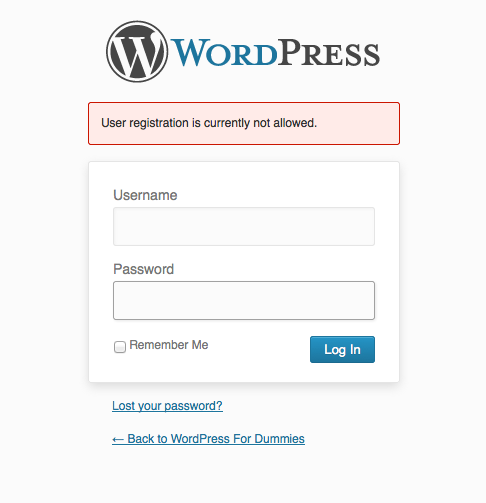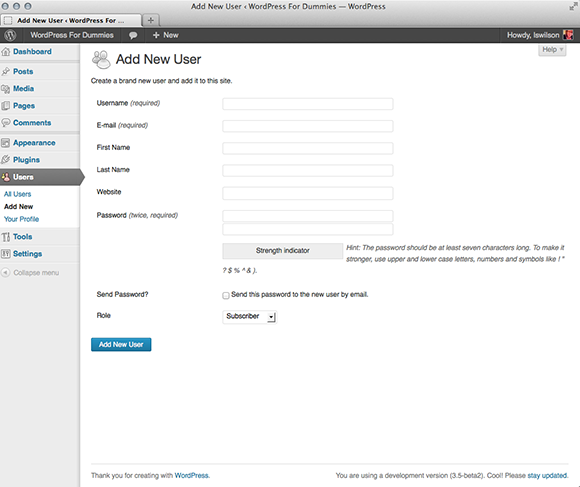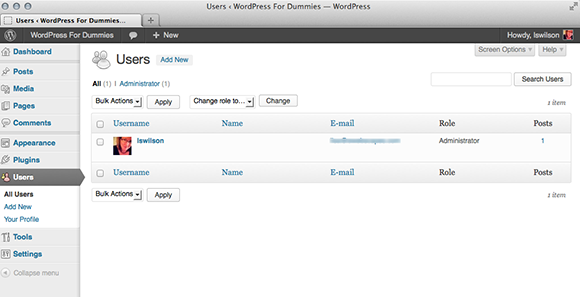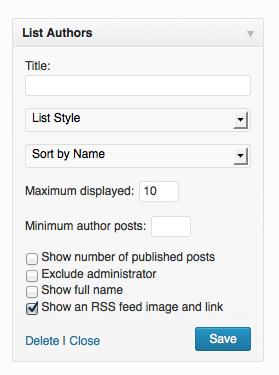Chapter 3: Managing Users and Multiple Authors
In This Chapter
 Deciding what roles to assign users
Deciding what roles to assign users
 Allowing new users to register
Allowing new users to register
 Adding a new user
Adding a new user
 Making changes to user profiles
Making changes to user profiles
 Using tools to manage multi-author sites
Using tools to manage multi-author sites
Multi-author blogging means inviting others to coauthor, or contribute articles, posts, pages, or other content to your blog. You can expand the offerings on your website or blog by using multi-author blogging because you can have several different people writing on different topics or offering different perspectives on the same topic. Many people use it to create a collaborative writing space on the web, and WordPress doesn’t limit you in the number of authors you can add to your blog.
Additionally, you can invite other people to register as subscribers, who don’t contribute content but are registered members of the blog, which can have benefits, too. (For example, you could make some content available to registered users only.)
This chapter takes you through the steps of adding users to your blog, takes the mystery out of the different user roles and capabilities, and gives you some tools for managing a multi-author website.
Understanding User Roles and Capabilities
Before you start adding new users to your site, you need to understand the differences among the user roles because each user role is assigned a different level of access and grouping of capabilities to your blog, as follows:
 Subscriber: The default role. Maintain this role as the one assigned to new users, particularly if you don’t know who’s registering. Subscribers get access to the Dashboard page, and they can view and change the options in their profiles on the Your Profile and Personal Options page. (They don’t have access to your account settings, however — only to their own.) Each user can change her username, e-mail address, password, bio, and other descriptors in her user profile. The WordPress database stores subscribers’ profile information, and your blog remembers them each time they visit, so they don’t have to complete the profile information each time they leave comments on your blog.
Subscriber: The default role. Maintain this role as the one assigned to new users, particularly if you don’t know who’s registering. Subscribers get access to the Dashboard page, and they can view and change the options in their profiles on the Your Profile and Personal Options page. (They don’t have access to your account settings, however — only to their own.) Each user can change her username, e-mail address, password, bio, and other descriptors in her user profile. The WordPress database stores subscribers’ profile information, and your blog remembers them each time they visit, so they don’t have to complete the profile information each time they leave comments on your blog.
 Contributor: In addition to the access subscribers have, contributors can upload files and write, edit, and manage their own posts. Contributors can write posts, but they can’t publish the posts; the administrator reviews all contributor posts and decides whether to publish them. This setting is a nice way to moderate content written by new authors.
Contributor: In addition to the access subscribers have, contributors can upload files and write, edit, and manage their own posts. Contributors can write posts, but they can’t publish the posts; the administrator reviews all contributor posts and decides whether to publish them. This setting is a nice way to moderate content written by new authors.
 Author: In addition to the access contributors have, authors can publish and edit their own posts.
Author: In addition to the access contributors have, authors can publish and edit their own posts.
 Editor: In addition to the access authors have, editors can moderate comments, manage categories, manage links, edit pages, and edit other authors’ posts.
Editor: In addition to the access authors have, editors can moderate comments, manage categories, manage links, edit pages, and edit other authors’ posts.
 Administrator: Administrators can edit all the options and settings in the WordPress blog.
Administrator: Administrators can edit all the options and settings in the WordPress blog.
 Super Admin: This role exists only when you have the multisite feature activated in WordPress — see Book VIII for more about the multisite feature.
Super Admin: This role exists only when you have the multisite feature activated in WordPress — see Book VIII for more about the multisite feature.
Table 3-1 gives you an at-a-glance reference for the basic differences in roles and capabilities for WordPress users.

Allowing New User Registration
As you can see in Table 3-1, each user level has a different set of capabilities. Book III, Chapter 2 discusses the General Settings in the WordPress Dashboard, in which you set the default role for users who register on your website. Keep the default role set to Subscriber because when you open registration to the public, you don’t always know who’s registering until after they register — and you don’t want to arbitrarily hand out higher levels of access to the settings of your website unless you know and trust the user.
When users register on your website, you, as the Administrator, get an e-mail notification (sent to the e-mail address you set on the General Settings page), so you always know when new users register, and you can then go into your Dashboard and edit the user to set his role any way you see fit.

Figure 3-1: The message to users that registration isn’t allowed.
By the way, the direct URL for registration on a blog that has registration enabled is http://yourdomain.com/wp-register.php. With registration enabled (in the General Settings), a user sees a form inviting her to input her desired username and e-mail address. After she does, she gets a confirmation notice in her inbox that includes an authorization link that she must click in order to authenticate her registration.
After a user has registered, you, as the site Administrator, can manage her user account and assign a user role. (Refer to Table 3-1.)
Adding New Users Manually
Allowing new users to register by using the WordPress registration interface is only one way to add users to your site. As the site Administrator, you have the ability to add new users manually by following these steps:
1. Log in to your WordPress Dashboard by inputting your username and password in the form at http://yourdomain.com/wp-admin.
2. Click the Add New link on the Users menu on the Dashboard.
The Add New User page, shown in Figure 3-2, loads.

Figure 3-2: The Add New User page in the WordPress Dashboard.
3. Enter the username in the Username text box.
You can’t skip this text box. The new user types in this username when he’s prompted to log in to your site.
4. Enter the user’s e-mail address in the E-Mail text box.
You can’t skip this text box, either. The user receives notifications from you and your site at this e-mail address.
5. Enter the user’s first name in the First Name text box.
6. Enter the user’s last name in the Last Name text box.
7. Enter the URL for the user’s website in the Website text box.
8. Enter the desired password in the Password text box.
WordPress asks you to type the password twice as a way of authenticating the password (making sure that you typed it correctly the first time). WordPress provides a strength indicator that gives you an idea of how strong, or secure, your chosen password is. You want secure passwords so that no one can easily guess them, so make the password at least seven characters long and use a combination of letters, numbers, and symbols (such as @, #, $, and ^).
9. If you want the user to receive his password by e-mail, select the Send This Password to the New User by Email check box.
10. Select Subscriber, Contributor, Author, Editor, or Administrator from the Role drop-down list.
11. Click the Add New User button.
The Add New User page loads and the e-mail notification is sent to the user you just added. When the page loads, all the fields are cleared, allowing you to add another new user, if you want.
Editing User Details
After users register and settle into their accounts on your site, you, as the site Administrator, have the ability to edit their accounts. You may never have to edit user accounts at all; however, you have the option if you need it. Most often, users can access the details of their own accounts and change e-mail addresses, names, passwords, and so on; however, circumstances under which you may need to edit user accounts would be to do things such as
 Edit user roles. When a user registers, you may want to increase her role, or level of access, on your site; promote an existing user to Administrator; or conversely, demote an existing Administrator or Editor down a notch or two.
Edit user roles. When a user registers, you may want to increase her role, or level of access, on your site; promote an existing user to Administrator; or conversely, demote an existing Administrator or Editor down a notch or two.
 Edit user e-mails. If a user loses access to the e-mail account that she registered with, she may ask you to change her account e-mail address so that she can access her account notifications again.
Edit user e-mails. If a user loses access to the e-mail account that she registered with, she may ask you to change her account e-mail address so that she can access her account notifications again.
 Edit user passwords. If a user loses access to the e-mail account with which she registered, she can’t use WordPress’s Lost Password feature, which allows users to gain access to their account password through e-mail recovery. In that case, a user may ask you to reset her password for her so that she can log in and access her account again.
Edit user passwords. If a user loses access to the e-mail account with which she registered, she can’t use WordPress’s Lost Password feature, which allows users to gain access to their account password through e-mail recovery. In that case, a user may ask you to reset her password for her so that she can log in and access her account again.
In any of these circumstances, you can make the necessary changes by clicking the Users link on the Users menu on your WordPress Dashboard, which loads the Users page shown in Figure 3-3.

Figure 3-3: The Users page lets you manage all the users on your site.
Figure 3-3 shows you the Users page on a site that has multiple users who have different levels of access, or roles. (The e-mail address is blurred in Figure 3-3 to protect the user’s privacy.)
When you hover your mouse pointer over the name of the user, an Edit link appears below the user listing. Click that Edit link to access the Edit User page, where you can edit different pieces of information for that user, including
 Personal Options: These options include Visual Editor and Color Scheme preferences.
Personal Options: These options include Visual Editor and Color Scheme preferences.
 Name: Specify a user’s role, first and last name, and nickname.
Name: Specify a user’s role, first and last name, and nickname.
 Contact Info: Includes users’ e-mail addresses; websites; and AIM, Yahoo! IM, and Google Talk IDs.
Contact Info: Includes users’ e-mail addresses; websites; and AIM, Yahoo! IM, and Google Talk IDs.
 Biographical Info: A few lines of biographical info for the user (optional, but some WordPress themes display authors’ biographies).
Biographical Info: A few lines of biographical info for the user (optional, but some WordPress themes display authors’ biographies).
 New Password: Change the password for the user.
New Password: Change the password for the user.
The Edit User page looks the same, and has the very same features, as the Profile page that you deal with in Book III, Chapter 2 — feel free to visit that chapter to get the lowdown on the different options and settings on this page.
Managing a Multi-Author Site
You may love running a multi-author site, but it has its challenges. The minute you become the owner of a multi-author site, you immediately assume the role of manager for the authors you invited into your space. At times, those authors look to you for support and guidance, not only on their content management, but also for tips and advice about how to use the WordPress interface — it’s a good thing you have this book at the ready so that you can offer up the gems of information you’re finding within these pages!
You can find many tools available to assist you in managing a multi-author site, as well as making your site more interactive by adding some features, which can make it a more rewarding and satisfying experience not only for you and your readers, but for your authors, as well.
The tools listed in the following sections come by way of plugins, which are add-ons that extend the scope of WordPress by adding different functionality and features. You can find information on the use and installation of plugins in Book VII.
Tools that help authors communicate
When you’re running a multi-author site, communication is crucial for sharing information, giving and receiving inspiration, and making certain that no two authors are writing the same (or a similar) article on your site. Use the following tools to help you manage the flow of communication between everyone involved:
 WP Status Notifier: In the section “Understanding User Roles and Capabilities,” earlier in this chapter, I mention that the role of Contributor can write and save posts to your site, but those posts don’t get published to the site until an Administrator approves them. This plugin notifies the Contributor author, via e-mail, when his post is published to (or rejected by) your site.
WP Status Notifier: In the section “Understanding User Roles and Capabilities,” earlier in this chapter, I mention that the role of Contributor can write and save posts to your site, but those posts don’t get published to the site until an Administrator approves them. This plugin notifies the Contributor author, via e-mail, when his post is published to (or rejected by) your site.
http://wordpress.org/extend/plugins/wp-status-notifier
 Editorial Calendar: This plugin gives you an overview of scheduled posts, post authors, and the dates when you scheduled the posts to publish to your blog. This plugin can help you prevent multiple author posts from publishing too close together or, in some cases, right on top of one another — you simply reschedule posts by using a drag-and-drop interface.
Editorial Calendar: This plugin gives you an overview of scheduled posts, post authors, and the dates when you scheduled the posts to publish to your blog. This plugin can help you prevent multiple author posts from publishing too close together or, in some cases, right on top of one another — you simply reschedule posts by using a drag-and-drop interface.
http://wordpress.org/extend/plugins/editorial-calendar
 Email Users: This plugin allows you to send e-mails out to all registered users of your blog, and users can send e-mails back and forth to one another by using the plugin interface on the Dashboard. This tool provides the authors and users on your multi-author blog the ability to keep in touch and communicate with one another.
Email Users: This plugin allows you to send e-mails out to all registered users of your blog, and users can send e-mails back and forth to one another by using the plugin interface on the Dashboard. This tool provides the authors and users on your multi-author blog the ability to keep in touch and communicate with one another.
http://wordpress.org/extend/plugins/email-users
 Subscribe to Authors Post Feed: This plugin adds an RSS feed to each author’s post archives, which allows you, other users, and site visitors to subscribe to that author’s RSS feed so that you receive immediate notification through your RSS feed reader when the author publishes new content.
Subscribe to Authors Post Feed: This plugin adds an RSS feed to each author’s post archives, which allows you, other users, and site visitors to subscribe to that author’s RSS feed so that you receive immediate notification through your RSS feed reader when the author publishes new content.
http://wordpress.org/extend/plugins/subscribe-to-author-posts-feed
 Dashboard Notepad: This plugin gives you a widget that appears on your main Dashboard page and allows you and other users (depending on the user role that you set in the plugin options) to leave notes for each other. You can use this plugin to ask and answer questions and to create to-do lists for your authors.
Dashboard Notepad: This plugin gives you a widget that appears on your main Dashboard page and allows you and other users (depending on the user role that you set in the plugin options) to leave notes for each other. You can use this plugin to ask and answer questions and to create to-do lists for your authors.
http://wordpress.org/extend/plugins/dashboard-notepad
Tools to promote author profiles
One way to operate a successful multi-author blog involves taking every opportunity to promote your authors and their information as much as possible. Authors often get involved in posting content on other websites, in addition to yours, for exposure, and the plugins in this list give you tools to promote authors bios, links, social network feeds, and more:
 Author Information Widget: This plugin gives you a widget that you can place in the sidebar of a single post page, displaying the post author’s name, biography (from the About Me section of the Author Profile page in the Dashboard), Avatar (author’s photo) and Social Network and Contact links.
Author Information Widget: This plugin gives you a widget that you can place in the sidebar of a single post page, displaying the post author’s name, biography (from the About Me section of the Author Profile page in the Dashboard), Avatar (author’s photo) and Social Network and Contact links.
http://wordpress.org/tags/author-info-widget
 List Authors: This plugin provides a widget that displays a list of the authors on your site, where the author’s name is a link to her post archive. Figure 3-4 displays the List Authors widget with the different options that you can set for it.
List Authors: This plugin provides a widget that displays a list of the authors on your site, where the author’s name is a link to her post archive. Figure 3-4 displays the List Authors widget with the different options that you can set for it.
http://wordpress.org/extend/plugins/list-authors

Figure 3-4: The List Authors widget options.
 Profile Pic: This plugin gives your authors the ability to add their own photos to their profiles on your site, and it provides you with a widget that can display each author’s photo, as well as his name and a link to his post archive.
Profile Pic: This plugin gives your authors the ability to add their own photos to their profiles on your site, and it provides you with a widget that can display each author’s photo, as well as his name and a link to his post archive.
http://wordpress.org/extend/plugins/profile-pic
 Author Spotlight: This plugin provides a widget that you can place in your sidebar, displaying the profile of the author of the post being viewed. The author information automatically appears on only a single post page and displays the profile of the author of the post.
Author Spotlight: This plugin provides a widget that you can place in your sidebar, displaying the profile of the author of the post being viewed. The author information automatically appears on only a single post page and displays the profile of the author of the post.
http://wordpress.org/extend/plugins/author-profile
 Author Based Twitter: This plugin gives your authors the ability to show their own Twitter feeds in the sidebar by using a handy widget. The author’s Twitter feed information appears on her post page only — so authors can promote their own Twitter accounts on your website.
Author Based Twitter: This plugin gives your authors the ability to show their own Twitter feeds in the sidebar by using a handy widget. The author’s Twitter feed information appears on her post page only — so authors can promote their own Twitter accounts on your website.
http://wordpress.org/extend/plugins/author-based-twitter-widget
Tools to manage multi-author blog posts
The plugins listed in this section can help you, the site Administrator, manage your group of authors and registered users by giving you some tools to track users’ activity, list their posts, and stay up-to-date and notified when your authors publish new content:
 Co-Authors Plus: This plugin allows you to assign multiple authors to one post, which you may find especially helpful when you have more than one author collaborating on one article, allowing the authors to share the byline and credit.
Co-Authors Plus: This plugin allows you to assign multiple authors to one post, which you may find especially helpful when you have more than one author collaborating on one article, allowing the authors to share the byline and credit.
http://wordpress.org/extend/plugins/co-authors-plus/faq
 Author Complete Post List: This plugin provides a very easy way to show a complete list of an author’s posts, enabling you to display an archive page per author.
Author Complete Post List: This plugin provides a very easy way to show a complete list of an author’s posts, enabling you to display an archive page per author.
http://wordpress.org/extend/plugins/author-complete-post-list
 Custom Author Byline: This plugin adds a custom author byline module below the Post Editor on the Add New Posts page, which enables you to include the name of an author who isn’t a registered member of your site (helpful when you need to give credit to collaborators).
Custom Author Byline: This plugin adds a custom author byline module below the Post Editor on the Add New Posts page, which enables you to include the name of an author who isn’t a registered member of your site (helpful when you need to give credit to collaborators).
http://wordpress.org/extend/plugins/custom-author-byline
 Pending Post Notifier: This plugin sends an e-mail to the site Administrator whenever posts are ready for review. For example, when a user who has the role of Contributor writes and saves a post, an e-mail is sent to the Administrator, telling him that new posts are awaiting his review.
Pending Post Notifier: This plugin sends an e-mail to the site Administrator whenever posts are ready for review. For example, when a user who has the role of Contributor writes and saves a post, an e-mail is sent to the Administrator, telling him that new posts are awaiting his review.
http://wordpress.org/tags/wp-pending-post-notifier
 Audit Trail: This plugin records the actions of the registered users on your site, such as when they log in or log out, when they publish posts and pages, and when they visit pages within your site. As the site Administrator, you can keep track of the actions your authors and users take on your website.
Audit Trail: This plugin records the actions of the registered users on your site, such as when they log in or log out, when they publish posts and pages, and when they visit pages within your site. As the site Administrator, you can keep track of the actions your authors and users take on your website.

 New users can register on your site only after you enable the Anyone Can Register option on the General Settings page within your Dashboard (Book III,
New users can register on your site only after you enable the Anyone Can Register option on the General Settings page within your Dashboard (Book III,